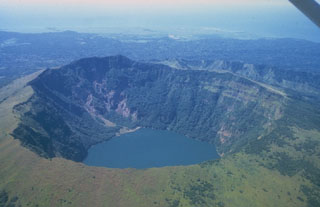Report on Cosiguina (Nicaragua) — December 1980
Scientific Event Alert Network Bulletin, vol. 5, no. 12 (December 1980)
Managing Editor: David Squires.
Cosiguina (Nicaragua) No fumarolic activity visible
Please cite this report as:
Global Volcanism Program, 1980. Report on Cosiguina (Nicaragua) (Squires, D., ed.). Scientific Event Alert Network Bulletin, 5:12. Smithsonian Institution. https://doi.org/10.5479/si.GVP.SEAN198012-344010
Cosiguina
Nicaragua
12.98°N, 87.57°W; summit elev. 872 m
All times are local (unless otherwise noted)
No fumarolic activity was visible from the rim [during a visit between mid-November. and early December.]
Geological Summary. Cosigüina (also spelled Cosegüina) is a low basaltic-to-andesitic composite volcano that is isolated from other eruptive centers in the Nicaraguan volcanic chain. The stratovolcano forms a large peninsula extending into the Gulf of Fonseca at the western tip of the country. It has a pronounced somma rim on the northern side; a young summit cone rises 300 m above the northern somma rim and buries the rim on other sides. The younger cone is truncated by a large elliptical prehistorical summit caldera, 2 x 2.4 km in diameter and 500 m deep, with a lake at its bottom. Lava flows predominate in the caldera walls, although lahar and pyroclastic-flow deposits surround the volcano. A brief but powerful explosive eruption in 1835 is Nicaragua's largest during historical time. Ash fell as far away as México, Costa Rica, and Jamaica, and pyroclastic flows reached the Gulf of Fonseca.
Information Contacts: R. Stoiber, S. Williams, H.R. Naslund, L. Malinconico, M. Conrad, Dartmouth College; S. Bonis, IGN, Guatemala; A. Aburto, D. Fajardo, Instituto de Investigaciones Sísmicas.

